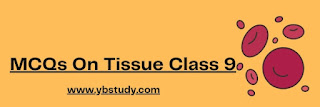Chapter 6 tissue MCQs class 9
MCQs On Tissue with answers class 9 pdf
Here Below we provide a list of Some Natural Phenomena Tissue MCQ class 9 outlined by experts who suggest the most important MCQ Question for class 9 science chapter 6 Tissue for various competitive exams. The below MCQ on tissue takes you directly to the corresponding topic where the detailed article along with class 9 science MCQs is provided for a smooth, effortless searching experience. Before going ahead to solved MCQ question for class 9 science chapter 6 papers or taking up mock tests, make sure you cover the Tissue MCQ and solve some sample questions before appearing in Exam. MCQ on Tissue with Answers Pdf listed below range from the basic to the most advanced Questions, thereby having you covered. Have a look at the list of MCQ below:
Chapter 6 Tissue class 9 science MCQs
1.Bone is important to the body since it____
(a) Transports gases and nutrients within the body.
(b) Acts as a fat reservoir.
(c) Fills up the space inside organs.
(d) Gives well-defined shape to the body.
Answer: D
2.Endothelium of the inner surface of blood vessels in vertebrates is formed of_________
(a) simple squamous epithelium
(b) columnar epithelium
(c) cuboidal epithelium
(d) ciliated cells
Answer: A
3.Which cell does not have perforated cell wall?
(a) Tracheids
(b) Companion cells
(c) Sieve tubes
(d) Vessels
Answer: B
4.The tissue composed of the living, thin-walled, polyhedral cell
(a) collenchyma
(b) parenchyma
(c) sclerenchyma
(d) striated muscle
Answer: B
5. Areolar connective tissue is found in _____
(a) between skin and muscle
(b) around blood vessel
(c) around nerves and bone marrow
(d) All of these
Answer: A
6. Each neuron has a single long part called______
(a) dendrite
(b) axon
(c) cell body
(d) cytoplasm
Answer: B
7. The shape of striated muscle cells is__________
(a) cylindrical
(b) spindle-shaped
(c) elongated with tapering ends
(d) spherical
Answer: A
8. Meristemetic tissues are those which help in increasing the length and girth of the plan. Which of the following statements given below is correct about the meristematic tissue?
(a) It is made up of cells that are incapable of cell division
(b) It is made up of cells that are capable of cell division
(c) It is composed of single type of cells
(d) It is composed of more than one type of cells
Answer:B
9. One of the following is not true about Cardiac muscles
(a) They can be controlled
(b) They lack mitochondria
(c) Cells are bi-nucleate
(d) All of the above
Answer: D
10. ________ is not found in xylem tissues.
(a) Sieve tubes
(b) Xylem parenchyma
(c)Tracheids
(d) Vessels
Answer: B
11. Rapid elongation of a bamboo stem is due to_______
(a) Lateral meristem
(b) Intercalary meristem
(c) Apical meristem
(d) None of the above
Answer: B
12. The function of dismantling and recycling in a cell is undertaken by_________
(a) Nucleus
(b) Chromosomes
(c) Lysosomes
(d) Mitochondria
Answer: C
13. The Nodes of Ranvier are found in_______
(a) Nerve cells
(b) Heart cells
(c) Liver cells
(d) All of the above
Answer: A
14. The dead element present in the phloem is_________
(a) Companion cells
(b) Phloem fibers
(c) Phloem parenchyma
(d) Sieve tubes
Answer: B
15. contractile proteins are found in________
(a) Bones
(b) Blood
(c) Muscles
(d) Cartilage
Answer: C
16. Intestine absorbs the digested food materials. What type of epithelial cells are responsible for that?
(a) Stratified squamous epithelium
(b) Columnar epithelium
(c) Spindle fibres
(d) Cuboidal epithelium
Answer: B
17. Meristematic tissues in plants are________
(a) localised and permanent
(b) not limited Lo certain regions
(c) localised and dividing cells
(d) growing in volume
Answer: C
18. Which is not a function of epidermis?
(a) Protection from adverse condition
(b) Gaseous exchange
(c) Conduction of water
(d) Transpiration
Answer: C
19. Fats are stored in human body as_______
(a) Cuboidal epithelium
(b) Adipose tissue
(c) Bones
(d) Cartilage
Answer: B
20. Voluntary muscles are found in______
(a) alimentary canal
(b) limbo
(c) iris of the eye
(d) bronchi of lungs
Answer: B
